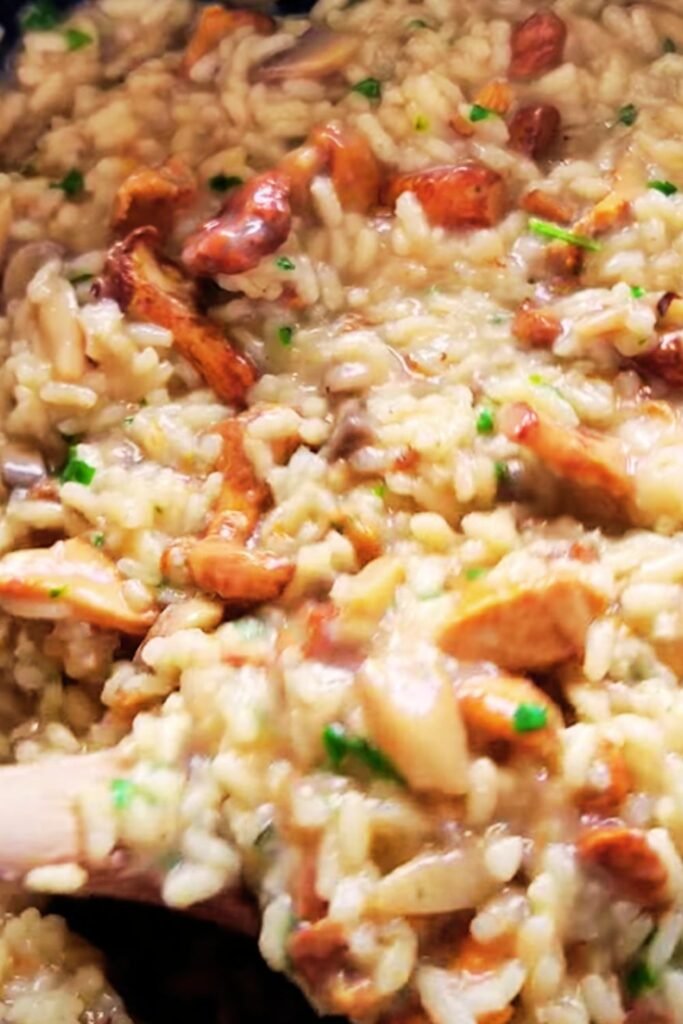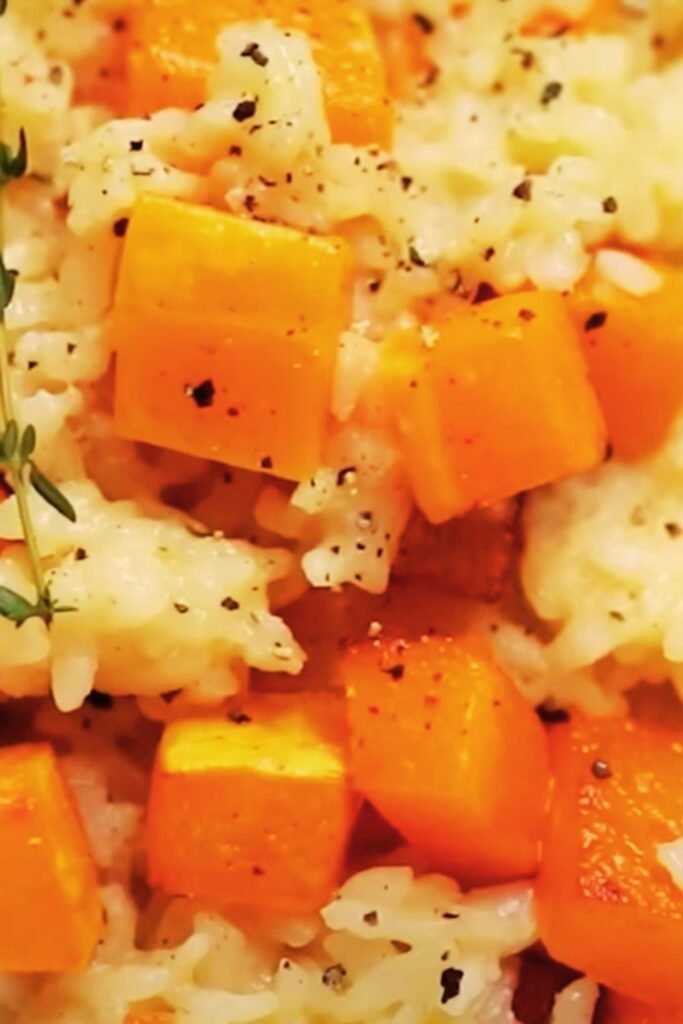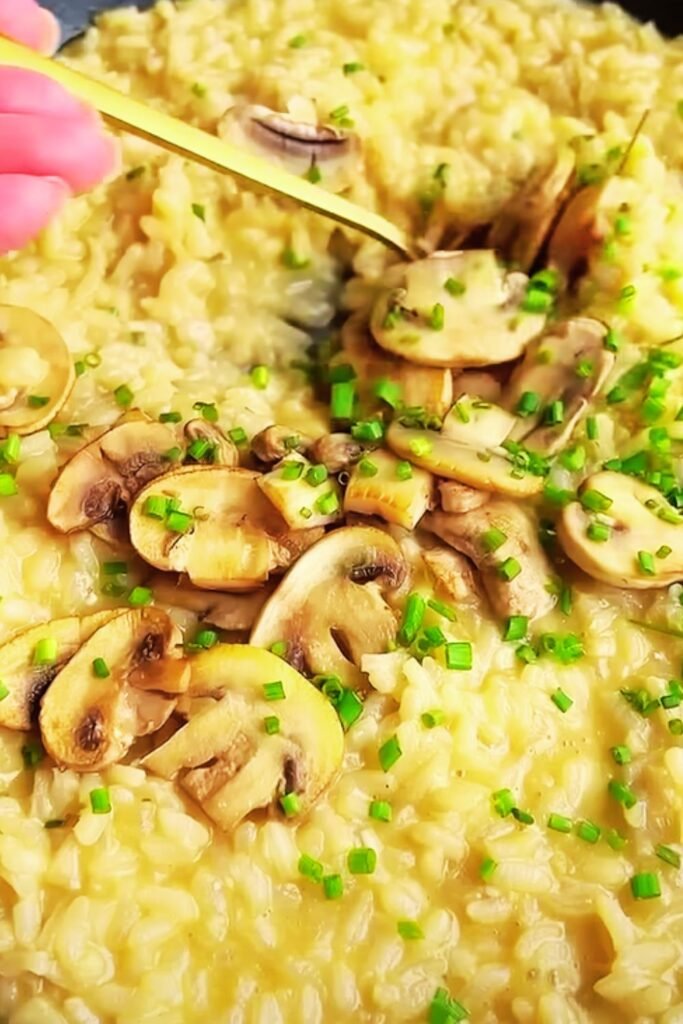There’s something magical about the way butternut squash and mushrooms come together in a perfectly creamy risotto. I’ve been making this dish for years, and it never fails to impress my family and friends. The sweet, nutty flavor of roasted butternut squash paired with earthy mushrooms creates a symphony of autumn flavors that’s both comforting and sophisticated.
When I first attempted this recipe, I was intimidated by the reputation of risotto being difficult to master. However, I’ve learned that with patience and the right technique, anyone can create restaurant-quality risotto at home. This butternut squash mushroom version has become my go-to recipe for cozy dinner parties and special occasions.
Understanding the Foundation: Key Ingredients
Before diving into the cooking process, let me walk you through the essential components that make this risotto extraordinary:
Arborio Rice: The heart of any great risotto : This short-grain Italian rice contains high levels of starch, which creates the signature creamy texture when slowly cooked and stirred. I always use Arborio rice because it absorbs liquid beautifully while maintaining its shape.
Butternut Squash: The sweet star ingredient : This winter squash brings natural sweetness and vibrant orange color to the dish. I prefer to roast it beforehand to concentrate the flavors and achieve the perfect tender texture.
Mixed Mushrooms: Earthy depth and umami : I typically use a combination of cremini, shiitake, and oyster mushrooms. Each variety contributes unique flavors and textures that complement the butternut squash beautifully.
Vegetable or Chicken Stock: The liquid foundation : Quality stock makes an enormous difference in the final result. I always keep my stock warm throughout the cooking process to maintain consistent temperature.
Dry White Wine: For depth and acidity : The wine adds complexity and helps balance the sweetness of the butternut squash. I use whatever dry white wine I have on hand, often Sauvignon Blanc or Pinot Grigio.
Preparation: Setting Yourself Up for Success
The key to perfect risotto lies in proper preparation. I’ve learned that having everything ready before you start cooking makes the process much smoother and more enjoyable.
Roasting the Butternut Squash
I begin by preheating my oven to 425°F (220°C). After peeling and cubing the butternut squash into 1-inch pieces, I toss them with olive oil, salt, and pepper. The roasting process takes about 25-30 minutes, and I know they’re ready when they’re tender and lightly caramelized around the edges.

Preparing the Mushrooms
While the squash roasts, I clean and slice my mushrooms. I’ve found that cooking them separately from the risotto initially gives better results. I sauté them in a hot pan with a bit of olive oil until they’re golden brown and their moisture has evaporated.
Stock Preparation
I always warm my stock in a separate saucepan and keep it at a gentle simmer throughout the cooking process. Adding cold stock to hot risotto can shock the rice and affect the final texture.
The Complete Butternut Squash Mushroom Risotto Recipe
Ingredients
| Ingredient | Quantity | Notes |
|---|---|---|
| Arborio rice | 1½ cups | Short-grain Italian rice |
| Butternut squash | 2 lbs | Peeled and cubed |
| Mixed mushrooms | 12 oz | Cremini, shiitake, oyster |
| Vegetable stock | 6 cups | Kept warm |
| Dry white wine | ½ cup | Room temperature |
| Yellow onion | 1 medium | Finely diced |
| Garlic cloves | 3 large | Minced |
| Parmesan cheese | 1 cup | Freshly grated |
| Unsalted butter | 4 tbsp | Divided |
| Extra virgin olive oil | 3 tbsp | High quality |
| Fresh thyme | 2 tsp | Or 1 tsp dried |
| Fresh sage | 1 tbsp | Chopped |
| Salt | To taste | Sea salt preferred |
| Black pepper | To taste | Freshly ground |
| Heavy cream | 2 tbsp | Optional, for extra richness |
Nutritional Information per Serving
| Nutrient | Amount | % Daily Value |
|---|---|---|
| Calories | 385 | 19% |
| Total Fat | 12g | 15% |
| Saturated Fat | 5g | 25% |
| Cholesterol | 22mg | 7% |
| Sodium | 890mg | 39% |
| Total Carbohydrates | 58g | 21% |
| Dietary Fiber | 4g | 14% |
| Sugars | 8g | – |
| Protein | 14g | 28% |
| Vitamin A | 184% | 184% |
| Vitamin C | 35% | 35% |
| Calcium | 25% | 25% |
| Iron | 15% | 15% |
Step-by-Step Instructions
Step 1: Prepare the Butternut Squash I start by roasting the butternut squash as described above. This can be done up to a day ahead, which makes the actual risotto preparation much easier.
Step 2: Sauté the Mushrooms In a large skillet, I heat 1 tablespoon of olive oil over medium-high heat. I add the sliced mushrooms and cook them without stirring for 3-4 minutes, allowing them to develop a golden crust. Then I stir and continue cooking until all moisture evaporates, about 5 more minutes. I season with salt and pepper, then set aside.
Step 3: Begin the Risotto Base In a heavy-bottomed saucepan or Dutch oven, I heat 2 tablespoons of olive oil and 1 tablespoon of butter over medium heat. I add the diced onion and cook until translucent, about 5 minutes. The key here is patience – I don’t want to brown the onion, just soften it.
Step 4: Add Garlic and Rice I add the minced garlic and cook for another minute until fragrant. Then I add the Arborio rice, stirring constantly for 2-3 minutes. This toasting process helps the rice maintain its shape during cooking and adds a subtle nutty flavor.
Step 5: Add Wine and Begin Stirring I pour in the white wine and stir until it’s almost completely absorbed. This usually takes about 2-3 minutes. The wine adds acidity that balances the sweetness of the butternut squash.
Step 6: Add Stock Gradually Now comes the meditative part of risotto making. I add warm stock one ladle at a time, stirring constantly until each addition is almost completely absorbed before adding the next. This process takes about 18-20 minutes total.

Step 7: Incorporate Vegetables After about 15 minutes of adding stock, I gently fold in the roasted butternut squash and sautéed mushrooms. I continue adding stock and stirring until the rice is creamy but still has a slight bite to it.
Step 8: Final Touches I remove the pan from heat and stir in the remaining butter, grated Parmesan cheese, fresh thyme, and sage. If I’m using cream, I add it now. I taste and adjust seasoning with salt and pepper.
Timing and Temperature Guide
| Phase | Time | Temperature | Key Points |
|---|---|---|---|
| Squash Roasting | 25-30 min | 425°F | Until tender and caramelized |
| Mushroom Sauté | 8-10 min | Medium-high | Until golden and moisture evaporates |
| Onion Softening | 5 min | Medium | Until translucent, not brown |
| Rice Toasting | 2-3 min | Medium | Until edges become translucent |
| Wine Addition | 2-3 min | Medium | Until almost absorbed |
| Stock Addition | 18-20 min | Medium | One ladle at a time |
| Final Assembly | 2-3 min | Off heat | Butter, cheese, herbs |
Mastering the Technique: My Personal Tips
Through years of making this recipe, I’ve discovered several techniques that elevate the final result:
The Stirring Technique
I use a wooden spoon and stir in a figure-eight pattern. This motion helps release the starch from the rice more effectively than circular stirring. I maintain a steady rhythm but don’t obsess over constant stirring – brief pauses won’t ruin the dish.
Stock Temperature Management
I keep my stock at a gentle simmer in a separate pan. Adding cold stock can shock the rice and interrupt the cooking process. I also taste my stock beforehand and adjust seasoning if needed.
Timing the Vegetables
I learned the hard way that adding the butternut squash too early can cause it to break down too much. Adding it during the last 5 minutes of cooking maintains its texture while allowing it to warm through.
The Final Mantecatura
This Italian term refers to the final mixing of butter and cheese off the heat. I add cold butter and stir vigorously to create an emulsion that gives the risotto its characteristic creamy finish.
Variations and Customizations
One of the things I love most about this recipe is its adaptability. Here are some variations I’ve successfully tried:
Protein Additions
- Roasted chicken thighs, shredded
- Pan-seared scallops
- Crispy pancetta or bacon
- Grilled shrimp
Vegetable Alternatives
- Roasted acorn squash instead of butternut
- Caramelized onions for extra sweetness
- Roasted Brussels sprouts for a bitter counterpoint
- Sun-dried tomatoes for umami depth
Cheese Variations
- Goat cheese for tanginess
- Gorgonzola for bold flavor
- Pecorino Romano for sharper taste
- Gruyère for nuttiness

Storage and Reheating Guidelines
While risotto is best enjoyed immediately, I understand that leftovers happen. Here’s how I handle storage and reheating:
Storage
I store leftover risotto in the refrigerator for up to 3 days in an airtight container. The rice will continue to absorb liquid and become firmer as it cools.
Reheating Methods
Stovetop Method: I add a splash of warm stock or water to the cold risotto and gently reheat over low heat, stirring frequently. This method gives the best results.
Microwave Method: I add a little liquid and reheat in 30-second intervals, stirring between each interval.
Oven Method: I cover the risotto with foil, add a bit of stock, and reheat at 350°F for 15-20 minutes.
Serving Suggestions and Pairings
This butternut squash mushroom risotto works beautifully as both a main course and a side dish. Here are my favorite ways to serve it:
As a Main Course
I serve generous portions (about 1 cup per person) with a simple arugula salad dressed with lemon vinaigrette. The peppery greens provide a nice contrast to the rich, creamy risotto.
As a Side Dish
Smaller portions (about ½ cup per person) pair wonderfully with:
- Grilled chicken or turkey
- Roasted pork tenderloin
- Pan-seared salmon
- Herb-crusted lamb chops
Garnish Ideas
- Toasted pine nuts or walnuts
- Fresh herbs like parsley or chives
- A drizzle of good olive oil
- Crispy sage leaves
- A sprinkle of paprika for color
Troubleshooting Common Issues
Over the years, I’ve encountered and solved various risotto challenges:
Mushy Rice
This usually happens when the heat is too high or the rice is overcooked. I’ve learned to maintain medium heat and test the rice frequently during the last 5 minutes of cooking.
Gummy Texture
Over-stirring can break down the rice too much. I stir regularly but not obsessively, and I use a gentle motion rather than aggressive stirring.
Lack of Creaminess
This often results from not releasing enough starch from the rice. I ensure I toast the rice properly and maintain consistent stirring throughout the cooking process.
Bland Flavor
Under-seasoned stock is usually the culprit. I always taste my stock and adjust seasoning before using it in the risotto.
The Science Behind Perfect Risotto
Understanding why risotto works the way it does has made me a better cook. The high starch content in Arborio rice, when slowly released through gentle cooking and stirring, creates the creamy texture without any cream. The gradual addition of warm liquid allows the rice to cook evenly while maintaining its shape.
The butternut squash contributes natural sugars that caramelize during roasting, adding depth and complexity. The mushrooms provide umami compounds that enhance the overall flavor profile. The wine adds acidity that balances the sweetness and helps break down the rice’s outer layer.
Seasonal Adaptations
While I associate this dish with autumn, I’ve adapted it for other seasons:
Spring Version
I substitute asparagus and peas for the butternut squash, add fresh mint, and use a lighter stock.
Summer Version
I use zucchini and yellow squash, add fresh basil and cherry tomatoes, and finish with lemon zest.
Winter Version
I add roasted root vegetables like parsnips and carrots, use heartier herbs like rosemary, and sometimes include a touch of cream for extra richness.
Making It Ahead: Partial Preparation
While risotto is best made fresh, I can prepare components ahead:
Day Before
- Roast the butternut squash
- Sauté the mushrooms
- Prepare and warm the stock
- Dice the onion and mince the garlic
Day Of
- Warm the pre-made components
- Cook the risotto fresh
- Assemble everything together
This approach saves time while maintaining quality.
Questions and Answers
Q: Can I make this risotto dairy-free? I’ve successfully made dairy-free versions by substituting the butter with olive oil and using nutritional yeast instead of Parmesan cheese. The texture is slightly different, but the flavor remains delicious.
Q: What’s the best way to reheat leftover risotto? I find the stovetop method works best. I add a splash of warm stock and gently reheat over low heat, stirring frequently. This helps restore some of the original creamy texture.
Q: Can I use other types of rice? While Arborio is traditional, I’ve had success with other short-grain rices like Carnaroli or Vialone Nano. Long-grain rice won’t work because it doesn’t contain enough starch to create the creamy texture.
Q: How do I know when the risotto is done? The rice should be tender but still have a slight bite (al dente). The mixture should be creamy and flow slightly when you shake the pan. If it’s too thick, I add a bit more warm stock.
Q: Can I freeze this risotto? I don’t recommend freezing risotto as the texture changes significantly when thawed. The rice becomes mushy and loses its creamy consistency.
Q: What wine should I use for cooking? I use any dry white wine that I would drink. Sauvignon Blanc, Pinot Grigio, or Chardonnay all work well. I avoid cooking wines that are too sweet or oaky.
Q: How can I make this recipe vegetarian? This recipe is already vegetarian if you use vegetable stock instead of chicken stock. Make sure your Parmesan cheese is made with vegetable rennet if you’re strictly vegetarian.
Q: Can I add other vegetables? Absolutely! I’ve successfully added roasted bell peppers, caramelized onions, sun-dried tomatoes, and even roasted cauliflower. Just be mindful of cooking times and add them at the appropriate stage.
Q: Why does my risotto turn out gluey? This usually happens from over-stirring or using too high heat. I maintain medium heat and use a gentle stirring motion. Also, make sure you’re using the right type of rice – long-grain rice will never give you the proper texture.
Q: Can I make this in a pressure cooker or instant pot? While it’s possible, I prefer the traditional stovetop method because it gives me more control over the texture. The slow, gradual cooking process is part of what makes risotto special.
This butternut squash mushroom risotto has become one of my signature dishes, and I hope it becomes one of yours too. The combination of sweet butternut squash, earthy mushrooms, and creamy rice creates a comfort food that’s both elegant and satisfying. With practice and patience, you’ll master this technique and be able to create countless variations to suit your taste and the seasons.